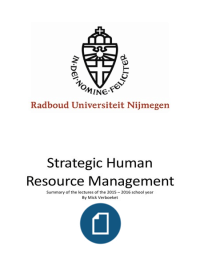Summary
Summary Lectures shame (2015)
Summary of all lectures or SHRM (Strategic Human Resource Management) of the 2015/2016 academic year for students of the Radboud University. Summary of the colleges of SHRM in the academic year 2015/2016 for students at Radboud University.
[Show more]
Preview 6 out of 42 pages
Uploaded on
January 12, 2016
Number of pages
42
Written in
2015/2016
Type
Summary
Institution
Radboud Universiteit Nijmegen (RU)
Education
Bedrijfskunde
Course
Strategisch HRM
All documents for this subject (6)
Strategic




